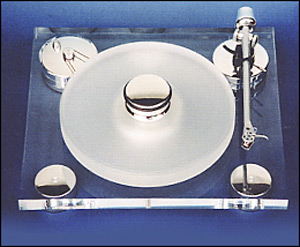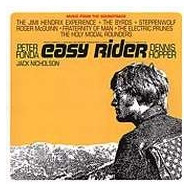You are reading the older HTML site
Positive Feedback ISSUE 9
october/november 2003
transrotor
Leonardo 25/40 turntable and Shelter 501 II MC cartridge
as reviewed by Roger S. Gordon

ROGER S. GORDON'S SYSTEM LOUDSPEAKERS ELECTRONICS SOURCES CABLES ACCESSORIES
|
Over the last twenty years, I have read hundreds of reports of the death of vinyl, but despite these reports, LPs appear to be doing quite well. While it is true that vinyl occupies a smaller market niche than before, the technology has continued to advance, so I was excited with the prospect of hearing a new turntable/tonearm/cartridge combination. My own LP playback system started life as a VPI Mk III turntable with a stock Eminent Technology ET II tonearm and a nondescript cartridge, all of which I purchased used. Over the years (as discussed in Positive Feedback, Vol. 5, No. 5 and Vol. 7, No. 4), the turntable was upgraded to a Mk IV, the ET II was upgraded to a 2.5, then modified to the maximum possible extent, and I currently use a Benz Reference cartridge.
The approximate retail price for my turntable setup is $2000 for the VPI Mk IV, $2500 for the ET II, and $3000 for the cartridge. The Transrotor turntable/tonearm combination, without cartridge, sells for approximately $2000, and the Shelter 501 II cartridge for around $800, while the entire combination can be purchased for the discounted price of $2500. My playback system, being much more costly, should sound much better, right? Wrong. Due to the law of diminishing returns with which we are all familiar, spending twice as much money on a piece of audio equipment usually only yields a 10% improvement in the sound, so I was interested to see how the Transrotor/Shelter combination compared to my setup.
The Transrotor is much smaller than the VPI, which requires its own stand (a Lead Balloon and a Bright Star sandbox with the stand-alone motor assembly cutout). Because of its compact size, the Transrotor fit very easily on the middle rack of my equipment shelf—a definite plus. I put the outboard power supply on the bottom shelf, and the captive phono cable was long enough to connect to the phono stage on the top shelf. Assembling the Transrotor was a snap. The hardest part was using the supplied cotton gloves so that I didn’t get fingerprints on the acrylic or chrome. I don’t do well with gloves—my manual dexterity drops by several orders of magnitude with them on—but even with this handicap, the assembly took less than five minutes. After assembly, the turntable looked gorgeous.
Mounting the Shelter cartridge was made easy by the alignment template supplied by Transrotor. The template is a card that slips over the spindle. You loosely mount the cartridge on the arm, then place the needle on a designated spot. The cartridge is properly aligned when its body is parallel to a series of lines printed on the template. With some careful eyeballing, this can be done fairly quickly. Once the cartridge is aligned, just tighten the screws. Adjusting the tracking weight is simple if you have a stylus force gauge, and setting the anti-skating merely requires that you move the slide to the appropriate weight on the scale. I did that, then checked it with the anti-skating band on my Shure Test Record, and only a little adjustment was needed. After playing a few bands on the test record to make sure that the cartridge wires were hooked up correctly, I was ready for music. 1
 Since I was the second reviewer to listen to this setup, I knew that it was
already broken in. Nevertheless, I thought I should play a few LPs to let it settle in
before doing any critical listening. The first album I put on the turntable was the
soundtrack from Easy Rider (Dunhill Records DSX 50063). As the first notes of
Steppenwolf’s The Pusher filled the room, I thought, "This is good."
I played the album all the way through, tapping my feet and playing air guitar, then
played several more albums before I shut the system down for the night. For me, the first
test for any piece of audio equipment is, "Is it emotionally involving?" The
Transrotor/Shelter sucked me in on the first LP.
Since I was the second reviewer to listen to this setup, I knew that it was
already broken in. Nevertheless, I thought I should play a few LPs to let it settle in
before doing any critical listening. The first album I put on the turntable was the
soundtrack from Easy Rider (Dunhill Records DSX 50063). As the first notes of
Steppenwolf’s The Pusher filled the room, I thought, "This is good."
I played the album all the way through, tapping my feet and playing air guitar, then
played several more albums before I shut the system down for the night. For me, the first
test for any piece of audio equipment is, "Is it emotionally involving?" The
Transrotor/Shelter sucked me in on the first LP.
The next night I conducted my second test: "Is the Transrotor better than
Red Book CD?" I have found that a good vinyl playback system will sound better than a
comparably priced Red Book CD playback system. I had on hand a Shanling CD-T100 CD player
(MSRP $2000) with NOS Western Electric 2C51 vacuum tubes replacing the stock Chinese 6P3s
on the tube output. 2 I first played the "Isa Lei" track from
the Water Lily CD A Meeting by the River with Ry Cooder and V.M. Bhatt (WLA-CS-29).
I  then played the
same recording on the Transrotor, which can be found on side six of the Dead Man
Walking soundtrack (Classic Records’ reissue of Columbia C3 67989). I then played
"The Song of the Sibyl" track from Dead Can Dance’s A Passage in
Time CD (Ryko 4AD RCD 20215) on the Shanling and the same track from the original Aion
LP (4AD CAD 0007) on the Transrotor. While the CD tracks were enjoyable, the music
really came alive when played on the Transrotor. The difference was so large that that
there was no point trying any additional comparisons.3
then played the
same recording on the Transrotor, which can be found on side six of the Dead Man
Walking soundtrack (Classic Records’ reissue of Columbia C3 67989). I then played
"The Song of the Sibyl" track from Dead Can Dance’s A Passage in
Time CD (Ryko 4AD RCD 20215) on the Shanling and the same track from the original Aion
LP (4AD CAD 0007) on the Transrotor. While the CD tracks were enjoyable, the music
really came alive when played on the Transrotor. The difference was so large that that
there was no point trying any additional comparisons.3
On to the next test—a comparison of the Transrotor/Shelter with my VPI/ET II/Benz. I compared a number of LPs by first playing them on the Transrotor and then on the VPI. The results were consistent. Both playback systems were emotionally involving. The Transrotor had a "white" sound, while the VPI/ET II/Benz was dark. It was Yin versus Yang. The Transrotor was not bright or washed out, but it was clearly at the opposite end of the scale from the VPI. This is neither good nor bad—it just is. Both systems had big, broad soundstages—deep, but not cavernous. Both clearly fixed the instruments in space. It was only in the subtle details that the VPI indicated that for triple the money, you get more coherence, palpability, and bass. With the VPI, all of the instruments were clearly in the same acoustic space. With the Transrotor, the instruments were in the same positions in the soundstage that they were with the VPI, but the sense that all of the instruments were in one space was missing. The instruments were not connected with each other. With the VPI, the instruments had three dimensions, and seemed to be real instruments played by a real orchestra. With the Transrotor, the instruments were still three-dimensional, but did not seem as solid, and the illusion of real instruments playing in real space was not as convincing.
My VMPS FF-3 loudspeakers are down 3dB at 24 Hz, so I can hear all of the bass produced by an orchestra, except for the lowest pedal notes of the organ. Bass is the foundation on which the sound of the orchestra is built, and tuneful bass with realistic sound pressure levels is very important to me. With the VPI, I hear thunderous bass if it is on the recording. With the Transrotor, the bass is all there, but it is polite. It will not rattle your pants legs or stun small animals. If you use mini-monitors, you probably won’t notice the difference, but if you have full-range loudspeakers and listen to headbanger music or large-scale symphonies, you will not be getting everything that is possible.
To try to determine which of these differences were due to the turntable/tonearm combination and which were due to the Shelter cartridge, I mounted my Benz cartridge on the Transrotor tonearm and the Shelter cartridge on my ET II, then played the same LPs. With the Benz on the Transrotor, the sound was much closer to that of the VPI/ET II/Benz. The sound was more coherent, more palpable, and there was more bass. With the Shelter on the VPI, the whiteness of the Transrotor/Shelter sound was not as apparent. The coherence and palpability were improved, but not to the same extent as putting the Benz on the Transrotor. Bass was only slightly improved.
After all of this listening and comparing, what conclusions can be drawn? At its price point, I believe the Transrotor Leonardo/Shelter 501 II is a bargain. I heard hours upon hours of enjoyable, emotionally involving music from it. When listening just for fun, I did not notice what I was missing by not using my VPI. I just heard music. If you have the money, buying a better cartridge for the Transrotor will yield improvements. Putting the Transrotor on a more solid stand should also improve things, particularly in the bass. I would definitely put the Transrotor Leonardo on your audition list.

The Shelter does many things right. It brings the music alive in a way that many cartridges don’t. It does not add any noticeable colorations. Its errors are errors of omission, rather than ones of commission. The choice of a cartridge is a highly personal decision. You need to audition several cartridges until you find one that meets your tastes. If it is in your price range, the Shelter 501 II cartridge should also be added to your audition list. Roger S. Gordon
(1) I have actually had cartridges that are mis-wired internally. Thus, if you connect the wires to the cartridge according to the color codes, you end up with one channel being out of phase, the channels reversed, or both. Test records allow you to check for and correct these problems.
(2) The Western Electric 2C51s sound a lot better than the stock Chinese tubes, particularly in the bass. However, they are only half the height of the Chinese tubes, which destroys the visual effect of the Shanling, especially at night. Ah, the sacrifices we make on our path to audio nirvana.
(3) If my Sony SCD-1 had been available, I would have loved to have done the CD vs. LP comparison again. The stock Sony is a much better sounding unit than the Shanling, but my unit was in Portland, Oregon being extensively modified by Dan Wright. Article to follow.
Transrotor Leonardo 25/40 turntable
Retail: $1995
Shelter 501 II MC cartridge
Retail: $800
Shelter
web address: www.axiss-europe.de
Transrotor
web address: www.transrotor.de
US
Importer for Transrotor and Shelter
Axiss Distribution
TEL: 310. 329. 0187
web address: www.axiss-usa.com
